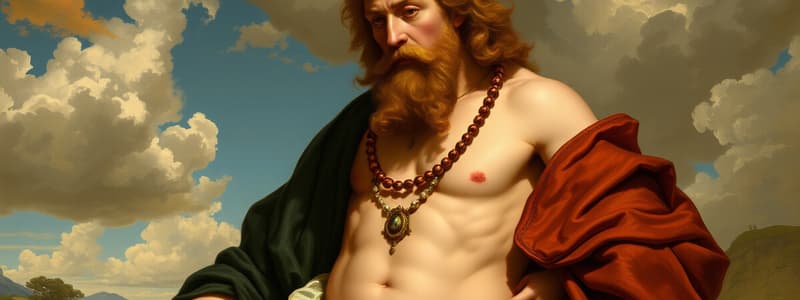Podcast
Questions and Answers
What was the first style Carracci was known for before developing his later works?
What was the first style Carracci was known for before developing his later works?
- Naturalistic style (correct)
- Mannerist style
- Baroque style
- Rococo style
What was the profession of Annibale Carracci's father?
What was the profession of Annibale Carracci's father?
- Butcher
- Goldsmith
- Tailor (correct)
- Artist
What significant contribution did Carracci and his family make to the art world?
What significant contribution did Carracci and his family make to the art world?
- Establishing a school of painting emphasizing classical art study (correct)
- Creating a goldsmith workshop
- Reviving Rococo painting
- Promoting Mannerism techniques
In which genre did Annibale Carracci make significant contributions during the Baroque period?
In which genre did Annibale Carracci make significant contributions during the Baroque period?
Which painting is cited as an example of Carracci's naturalism?
Which painting is cited as an example of Carracci's naturalism?
What was the main influence of Annibale Carracci's work on the development of painting in the seventeenth century?
What was the main influence of Annibale Carracci's work on the development of painting in the seventeenth century?
Which of the following characteristics distinguishes Caracci's figures in his fresco from Mannerism?
Which of the following characteristics distinguishes Caracci's figures in his fresco from Mannerism?
What notable event contributed to the tension between Carracci and Cardinal Farnese?
What notable event contributed to the tension between Carracci and Cardinal Farnese?
What is considered Carracci's masterpiece, located in the Farnese Palace?
What is considered Carracci's masterpiece, located in the Farnese Palace?
How did art historians rank Carracci's fresco work in comparison to Michelangelo’s Sistine Chapel?
How did art historians rank Carracci's fresco work in comparison to Michelangelo’s Sistine Chapel?
Flashcards are hidden until you start studying
Study Notes
Annibale Carracci: Overview
- Born in Bologna around 1560, son of a tailor and a butcher; did not come from an artistic family.
- Initially adopted a naturalistic style to counter the exaggerations of Mannerism, emphasizing common people in everyday situations.
- Evolved to create polished and exuberant works, bridging Mannerism to the Baroque style.
Artistic Development
- Began as an apprentice to a goldsmith; later worked for Mannerist artist Bartolomeo Passerotti.
- Collaborated with brother Agostino and cousin Ludovico to establish a Bologna painting school focused on classical art studies.
- Influenced by Venetian artists like Titian and Tintoretto, rejecting Mannerist excess for a more natural approach.
Key Works and Style
- Early work "The Beaneater" exemplifies naturalism, featuring a peasant with simple food, showcasing rough brushwork influenced by Flemish styles.
- Known for landscapes that prioritized naturalism; made sketching trips into the countryside, creating notable landscape paintings.
Landscape Innovations
- Pioneered a new approach to landscape painting, elevating it as a significant genre in the Baroque period.
- Landscapes often contained human figures, though nature remained the primary focus, reflecting a deep reverence for the environment.
Frescoes and Collaborations
- Worked with family to create influential frescoes in northern Italy; disputes arose among them by 1593.
- Commissioned by Cardinal Farnese in Rome to decorate the villa; led to the creation of his masterpiece, a ceiling fresco celebrated for its beauty and historical significance.
The Triumph of Bacchus and Ariadne
- Considered a pivotal work in art history, second only to Michelangelo's Sistine Chapel in importance; celebrates ancient Roman mythology rather than Christian themes.
- Features muscular, accurately proportioned figures, showcasing the exuberance and emotion characteristic of Baroque art.
Challenges and Financial Struggles
- Engaged on a contract by Cardinal Farnese for meals, lodging, and a stipend; faced delayed payments and harsh working conditions.
- Suffered public ridicule and exploitation during his six years of work on the Farnese frescoes, leading to his deteriorating health and eventual death post-contract.
Legacy
- Carracci's work marked a significant transition in Italian art, influencing the Baroque period and shaping future artistic standards.
- His struggles underscore the hardships artists faced in achieving recognition and fairness under patronage during the Renaissance and Baroque eras.
Studying That Suits You
Use AI to generate personalized quizzes and flashcards to suit your learning preferences.

